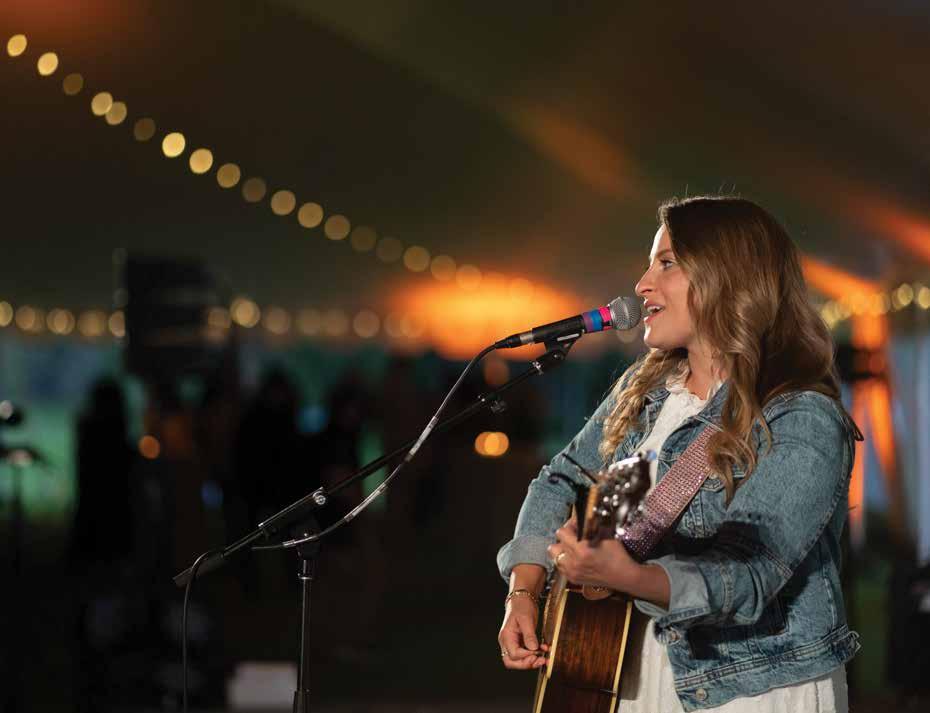MCelebration Century of a



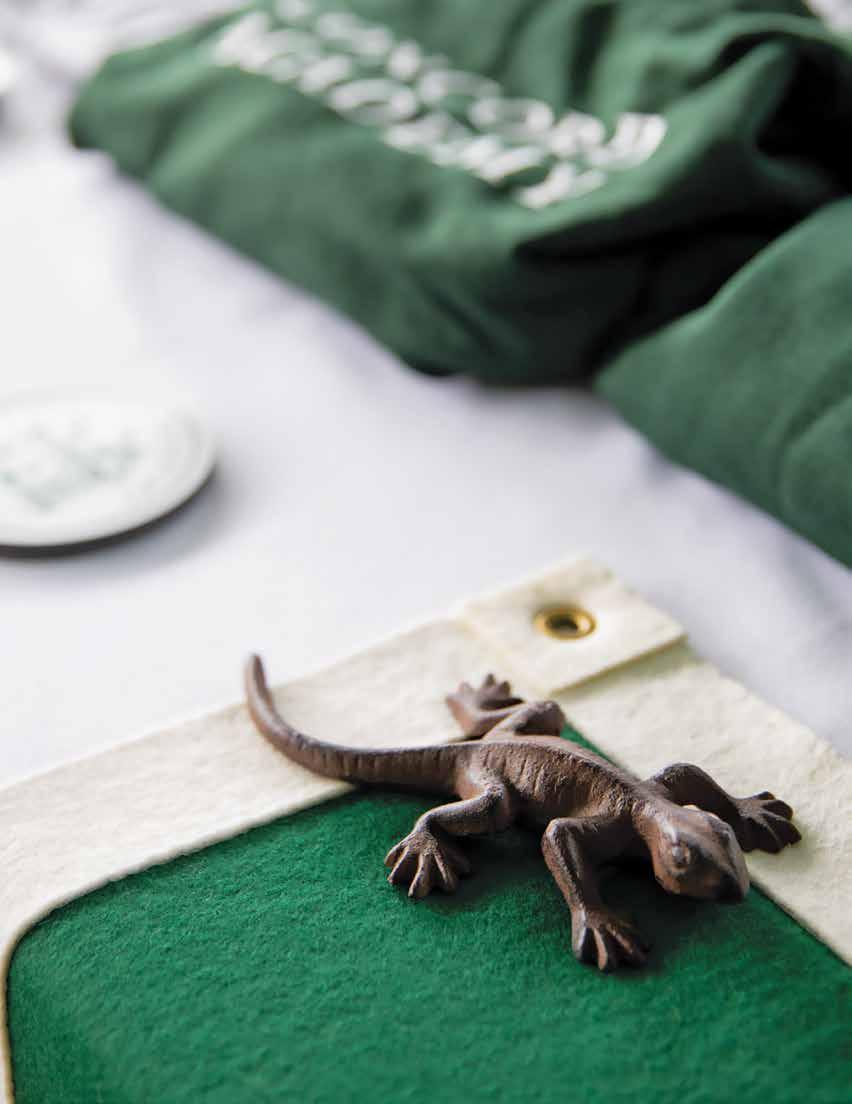
SUMMER 2023
16
Editor Heidi Koelz Senior Associate Director of Communications
Design Aldeia www.aldeia.design
Photography Nicholas Pfosi Assistant Director of Communications and Operations
Editorial Board Rob Munro Assistant Head forAcademic Program and Equity
Alice Roebuck P’25 Assistant Head for Advancement and Engagement
Heather Sullivan Director of Marketing and Communications
Sarah Yeh P’24 ’27 Associate Head for Teaching, Learning, and Faculty
Contact us: Concord Academy Magazine 166 Main Street Concord, MA 01742
(978) 402-2249 magazine@concordacademy.org
© 2023 Concord Academy
COVER PHOTO: COLE AND KIERA PHOTOGRAPHY
BACK COVER PHOTO: JODI HILTON
STAY IN TOUCH
Update your contact information with CA at www.concordacademy.org/stay-connected.
In its 100th year, CA celebrates Henry Fairfax’s installation
20
CA’s Centennial concludes with great festivity 28
Studying old-growth longleaf pines in Georgia, CA students discover more than meets the eye
02 Opening Remarks
Letter from the head of school

03 Campus Students, faculty, and campus events
36 Centennial Campaign
This is the year— help CA close the Centennial Campaign
39 Alums Sebastian Junger ’80, Chris Rosenberg ’86, CA Alum Annual Fund co-chairs, and Fay Lampert Shutzer ’65
46 Creative Types
47 Class Notes
91
Then & Now Larry Goldings ’86
92 End Space
Nancy Boutilier, English teacher
MISSION
We are a community animated by love of learning, diverse and striving for equity, with common trust as our foundation.
Honoring each individual, we challenge and expand our understanding of ourselves and the world through purposeful collaboration and creative engagement.
We cultivate empathy, integrity, and responsibility to build a more just and sustainable future.
Welcome home! That’s how I greeted hundreds of CA community members at our Centennial Celebration this June. It was an honor to speak on that occasion along with so many amazing individuals for whom CA has been a catalyst (page 20). As I said that weekend, let’s not wait another 100 years to do this again! I look forward to many more opportunities to come together. Concord Academy is built on relationships, after all. It’s one of our superpowers.
Saying those words—welcome home—was also humbling, because my journey to Concord was improbable. I was born and raised in West Philadelphia. An independent school education opened doors for me, but the school I attended as a teenager and later returned to as a professional never felt like home. Like so many institutions, it was not built for people like me. Now, CA’s story is a little different. This school started with a big vision for educating girls in an era when such visions were constrained. Striving for equity is in CA’s DNA, and that’s why I see our school as uniquely positioned to have a big influence in the world.

What does striving for equity look like in practice today? As a systems thinker, I’m conscious of needing to be a different kind of engineer or architect to reconfigure an educational experience that was not designed for all of our students. This is why it’s so important to address equity structurally, through growing our endowment (page 36). We’ll also need to keep listening to our students and knowing them as individuals. We’ll need to practice accountability and be leading learners, through and through. We’ll need to welcome courageous and critical conversations, to lean into uncomfortable discussion as part of the learning process.
That will happen thanks to the strength of our partnerships, at every level: with our students, our trustees, our parents, and our alums. I’m grateful that so many of you shared memories and dreams for CA with me during my first year. These conversations will shape our vision and strategy, which I look forward to co-authoring and guiding. Please know that my listening and learning tour will continue unofficially, and that you have a standing invitation to connect.
Go Green! HenryCA students volunteered at the Umbrella Arts Center’s Earth Day celebration near campus.
As part of this April event, they painted faces, played music, and marched in the town’s annual Earth Day parade.
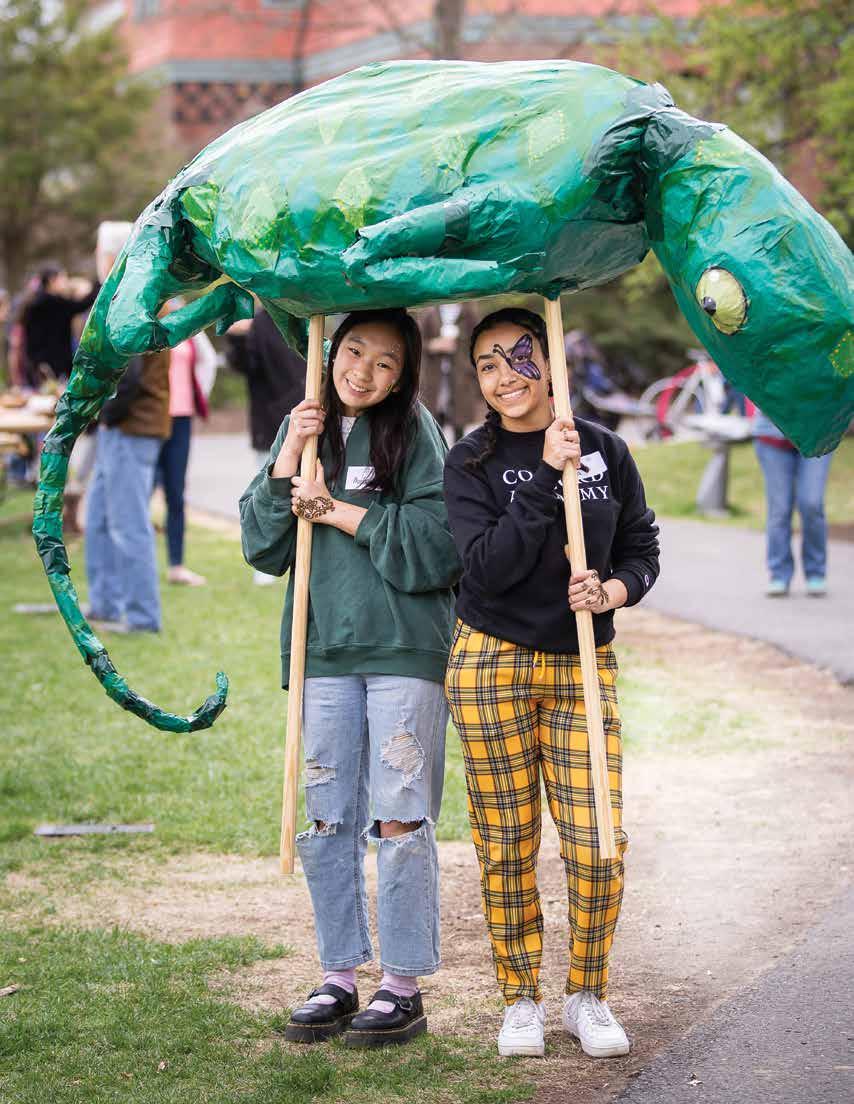
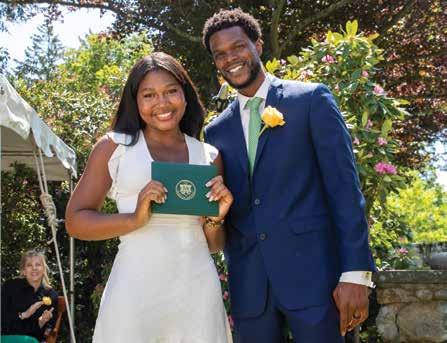
Concord Academy’s 100th school year culminated in a heartwarming ceremony on May 26. The spring morning couldn’t have been more beautiful, promising blue skies ahead for CA’s class of 2023. Fay Lampert Shutzer ’65, president of the Board of Trustees, highlighted the graduates’ resilience, optimism, authenticity, and joy. Head of School Henry Fairfax called them “some of the most thoughtful and passionate students anywhere.” Student Head of School Jayant Talwar ’23 expressed gratitude for CA’s faculty and staff and shared advice from this year’s senior chapels: Embrace change, see beauty in imperfections, and live with honesty and kindness without looking for reward.

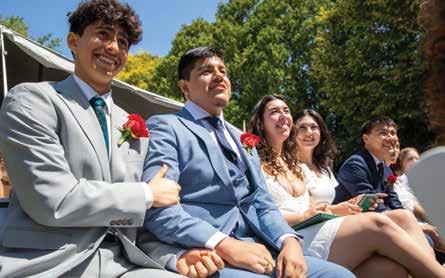
Svava Valfells ’23, senior class president, introduced the Centennial Commencement speaker, André Robert Lee, an award-winning audio, television, and film producer and, she said, “an incredibly inspiring role model.” In his address, Lee reflected on the care of his ancestors and the great changes that have taken place over the last century. He said the call to “speak truth to power” that originated with Civil Rights Movement architect Bayard Rustin was “a call to each of us, as individuals, to ensure that those in power can’t pacify us into complacency.”
Despite the many challenges our society faces today, he said, he is hopeful for the future. “It is only through hindsight that we will be able to see the change and growth of our current moment clearly,” he said, “but if the masses of individuals across this country who choose to speak truth to power are any indication, there is reason for hope and optimism.”
“[Love] is the way we achieve change. I believe that with an army of change agents, we can turn this world around.”
ANDRÉ ROBERT LEELEARN MORE Read more and watch the ceremony at concordacademy.org/ commencement-2023.
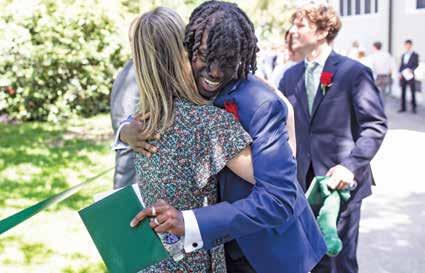





Today’s ceaseless news cycle provides plenty of scenarios for how the world might end, whether through climate catastrophe or artificial intelligence. To help students navigate this cultural concern with the collapse of complex global systems, this spring history teacher Topi Dasgupta P’22 ’25 and English teacher Laurence Vanleynseele P’22 co-taught an experimental class that turned toward existential crises without the distance of cynicism or the disembodiment of doomscrolling.
she says, and to “be engaged in the world and consider what a good future might look like.”
Vanleynseele says her research and the class discussions renewed her appreciation for artists and intellectuals who help us see from different vantage points. “It gave me a real sense of purpose,” she says, and it reinforced “the need for teaching about interconnected systems, undoing disciplinary silos, and the false dichotomy between thinking and activism.”
Students emerged with varied perspectives. Emerson Koch ’24 considered his individual environmental impact and started taking the train to school instead of driving. Graylin Rhee ’24 wrestled with the idea of transhumanism, a movement advocating enhancing human capacities with emerging technologies. She hasn’t come to terms with the state of the world, she says, but “I do have a much better understanding of where we are.”
“It’s not that the world is ending, and not that it’s fine,” Cozette Weng ’23 says, “but let’s think about how we’re thinking about it.” For a final project, she hand-sewed a period Chinese robe from a modern pattern and materials, interrogating assumptions about tradition.
One group of students created a collage, updating Hieronymus Bosch’s The Garden of Earthly Delights with contemporary imagery.
Harry Carranza ’24 recorded a podcast, relating the sciences and the humanities. “I feel more content knowing I have some vocabulary to deal with these issues, and some ability to think critically about them,” he says.
In Apocalypse, Whatever: Caring in the Age of Post-Truth, created with support from CA’s endowed Department X initiative, students engaged with the work of historians, cultural theorists, and filmmakers. Dasgupta and Vanleynseele set canonical texts such as Plato’s “Allegory of the Cave” and Shakespeare’s The Tempest in conversation with contemporary novels and philosophy. They embraced an emerging, responsive syllabus, or as Vanleynseele calls it, “a genuinely ongoing process of adaptation and collective discovery.”
Dasgupta wanted students to “end the course with good questions and not feel numb and turned off,”
Dasgupta and Vanleynseele are now collaborating on a paper about the course, which they hope to feature next year in the History Design Studio workshop at Harvard. Vanleynseele is excited to see how departments across CA will pick up the threads of their exploration. “The issues of the course are not going away,” she says.
Inspiration from campus speakers
Spring Session fosters experiential learning

The week prior to March break, CA teachers offered students a diverse array of short courses on topics such as tabletop game design and fiber arts experimentation with natural dyes. History teacher Kim Frederick, one of the faculty coordinators of Spring Session this year, says the aim of the week was to “give adults the capacity, the time, and the money to try things they wouldn’t try during the school year because it’s too risky.” She says she thinks of Spring Session a “pedagogy studio week,” in which collaboration is encouraged and assistance is available for teachers who want to try new things.
Several classes headed off campus to take advantage of the wealth of cultural
institutions in the Boston area, touring Fenway Park and the Harvard Art Museums and attending an open rehearsal of the Boston Symphony Orchestra. A course called Analog Joy Camp encouraged students to explore the city without seeing it through a smartphone camera. Some students created a music video at a professional studio. Others learned about immigration through culinary traditions, cooking meals together on campus and then meeting with chefs at several immigrant-owned restaurants. Students in a class about bike maintenance traveled to Lowell, Mass., to visit a nonprofit that repairs bikes and donates them to the community.
After Head of School Henry Fairfax converted his office into a barbershop in January, it wasn’t long before plans took shape for a similar community-building opportunity around women’s hairstyling. In April, Fairfax’s wife, Ivy, hosted a hair care and styling tutorial in coordination with Frizzed, the student curly-hair club, and the Community and Equity Office. Her longtime stylist from Philadelphia offered tips for more time-intensive hairstyles while students and faculty practiced on mannequins.

“Change does not roll in on the wheels of inevitability. If you want to have change, you have to fight for it.”
KELLIE CARTER JACKSON
Keynote Speaker, Martin Luther King Jr. Day 2023 Read more at concordacademy.org/mlk-2023.
“ We may have to redefine how the grid works to make it 100% renewable.”
KEVIN KOCH P’24 Solar systems designer Read more at concordacademy.org/koch.
SPOKEN WORD


In April, CA hosted its annual student-organized Gender Representation in Technology (GRIT) conference, which aims to empower women and genderqueer individuals to engage with confidence in science, technology, engineering, and math. Four of the five guest speakers at this series of in-person workshops for local middle and high school students were young CA alums.
Elisabeth Bellows ’72, a retired psychiatrist who is now an avid gardener, brought a worm farm to CA in April to share with students taking Advanced Environmental Science: Energy and Climate. The class has been studying the impact of human food production practices and considering the future of sustainable agriculture. In a presentation she developed with Sally Behr Schendel ’72, Bellows discussed techniques for vermicomposting, or composting with worms, and the advantages of this technique, before providing students with materials to create a new worm farm. When food waste goes into the landfill, she said, “we’re out of step with nature.”
LEARN MORE
Read more at concordacademy.org/worms.
In May, the Chameleon Chamber Players performed the world premiere of Rapid Transit at the Spring Music Concert.
Irene Zheng ’24 (piano), Nick Brady ’24 (violin), and Andra Dix (violin), CA’s director of chamber music and individual music instruction, gave life to this new piece by Centennial Composer-in-Residence
Curtis Hughes ’92, P’18. >>
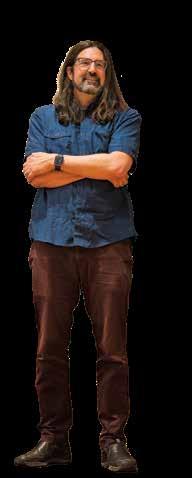
Data scientist Emma Starr ’12 hosted a panel discussion about using data for the public good. “I’m passionate about using data and statistics to empower people to better understand the world around them,” she said. Starr spoke about her work at a startup that partners with school districts nationwide to reduce absenteeism, talked about how data led to government intervention and health care compensation following the water crisis in Flint, Mich., and discussed data’s critical use for reform and policy change in addressing inequitable New York City stop-and-frisk laws.
Jennifer Rojas ’16 shared her experience as a woman of color and corporate software engineer who had felt out of place learning coding in college but, with determination, learned programming and data visualization. “I would tell my younger self,” she said, “if there’s no seat for you at the table, make your own!”
Additional sessions focused on making technology more accessible, with science teacher Iris Oliver ’15; finding one’s own working style, with user operations specialist Carolina Diez ’13; and applications of genetic engineering in neurobiology. The conference sparked meaningful conversations and motivated students from all backgrounds to pursue their interest in technology.
LEARN MORE
Read more at concordacademy.org/grit-2023.
In April at the Holy Family Parish, Ola Oladitan ’24 portrayed a young Frederick Douglass during his 1841 visit to Concord, Mass. Ola was one of two CA community members who took part in a program honoring the birth of antislavery activist and educator Ellen Garrison, 200 years ago. Rob Munro, assistant head for academics and equity at CA and a member of the Concord250 executive committee, which co-sponsored the event with the Robbins House, said in a public address, “It’s high time Ellen Garrison takes her place alongside other revered Concordians.”
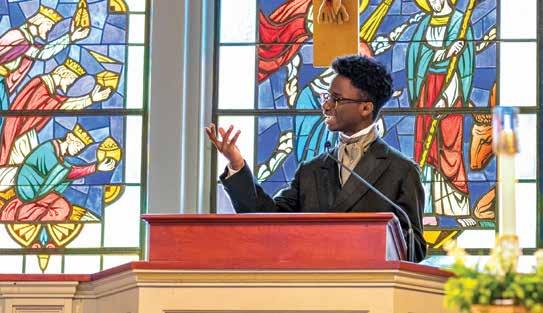
Henriette Lazaridis ’78 reads from her latest novel at CA
Author Henriette Lazaridis ’78 spoke with CA students about her career at an event hosted by the Chameleon literary and arts magazine in April. She also read from her newly published second novel, Terra Nova (page 46). Set in 1910 and inspired by the Antarctic expeditions of Capt. Robert Falcon Scott, the book alternates between the perspectives of Watts, an explorer racing toward the South Pole, and Viola, a photojournalist in London.
During the Q&A that followed, Lazaridis reflected on the CA faculty who had fostered her love of writing and on her time as an editor of the Chameleon. Addressing both her style and the publishing process, she offered students insight into a career in writing.
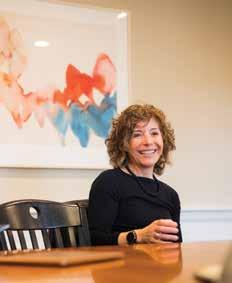
LEARN MORE
Read more at concordacademy.org/lazaridis.
Conceived by students and supported by faculty advisors, senior projects offer CA’s 12th graders a self-directed capstone experience. This spring, nearly a third of the senior class took on the challenge, yielding an extraordinary breadth of exploration. Projects spanned disciplines from finance to forensic science. Several students created unique artistic works. Others focused on renewable energy, microplastics, robotics, and gentrification. Director of Studies Alyse Ruiz-Selsky ’05 says probing a curiosity or following a passion puts the seniors “in the role of both teacher and student as they design a curriculum and live through it.”
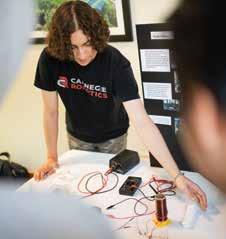
LEARN MORE
Read more at concordacademy.org/seniors-2023.
VISUAL ARTS
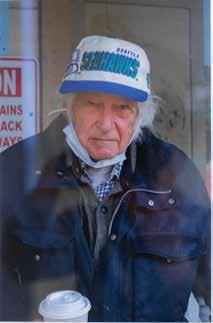

In May, student artwork from the spring semester was displayed in the Ransome Room.


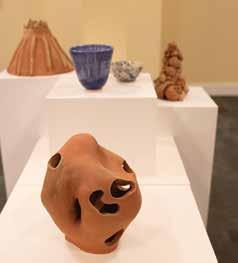

CA’s theater, dance, and music programs teamed up to wow audiences with whimsical performances of the musical Pippin in February.
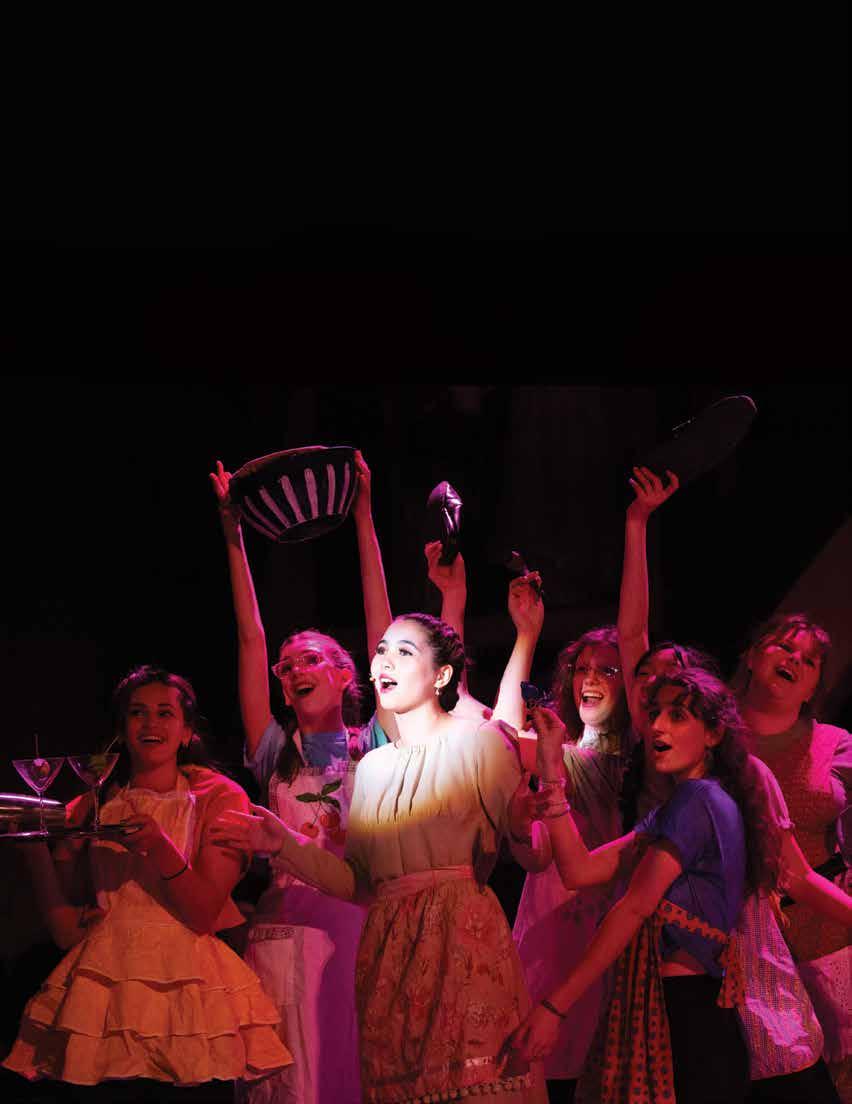 LEARN MORE Read more at concordacademy.org/pippin.
LEARN MORE Read more at concordacademy.org/pippin.
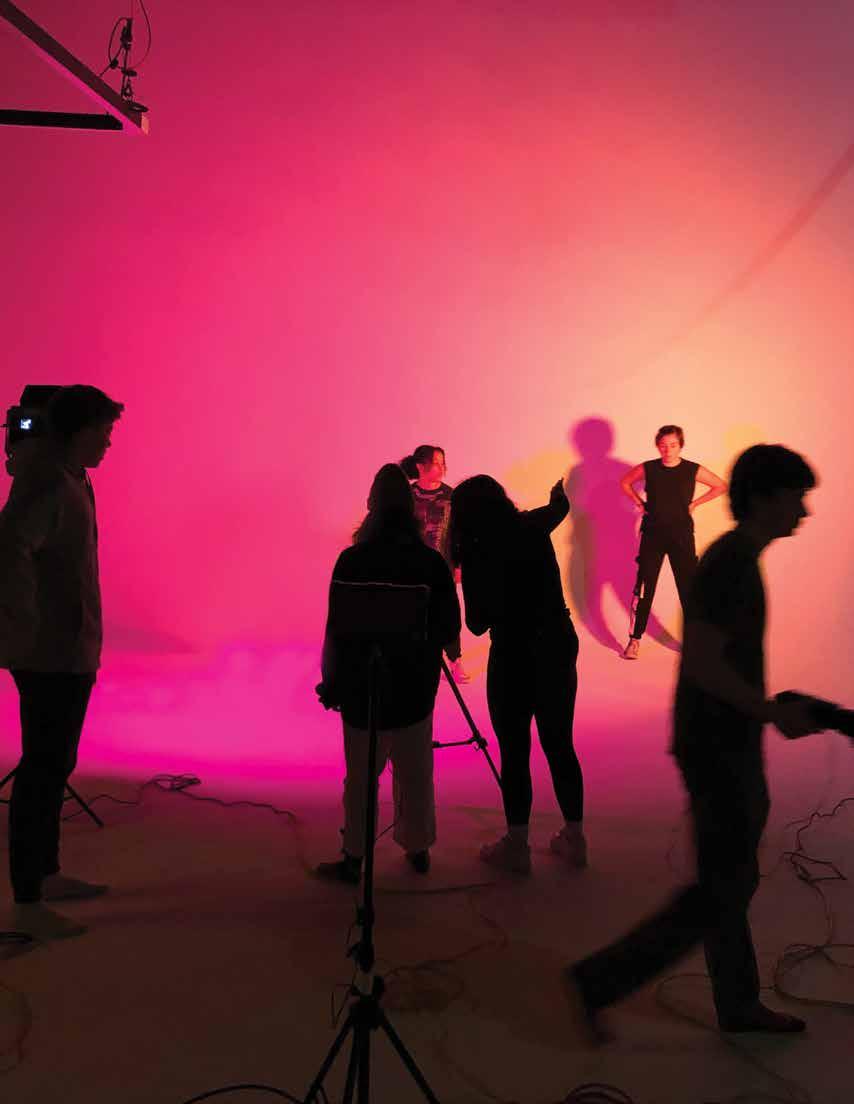
This spring, Concord Academy’s Film/Dance/Music Co-Lab broke barriers with a multidisciplinary art collaboration. Dance program co-director Rika Okamoto’s Choreographer’s Workshop and Dance Three classes created original dances to songs by music teacher Nate Tucker’s Digital Music Composition class. Students in the Special Topics: Cinematography course taught by film teacher Justin Bull P’25 captured the action.
“The natural crossover of the three disciplines is something I’ve always been interested in exploring with the students,” Bull says. “They all share a common language of composition, rhythm, and motifs.”
Teachers mentored students while giving them room to develop their creative ideas for four short films. “We had complete freedom over the style of choreography,” dance student Irene Jiang ’24 says. “Each of the four student choreographers brought distinct approaches—from hip-hop to contemporary. My inspiration came from my past experiences in jazz and K-pop dance, as well as the bold electronic music by Anni Taylor ’24 and Kai Feingold ’24 selected.”
The film students observed early versions of each dance and began generating visual approaches for the work. “We started preparing for the shoot weeks before the day by creating a mood board that covered aesthetics, lighting techniques, and cinematic choices that we wanted in our film,” Lucas First ’23 says. They came with a shot list and blocking chart to the film shoot at Windy Films, a Boston-based studio founded by Tripp Clemens ’09 and Harvey Burrell ’09.
“As their former teacher, it’s always a humbling experience to interact with Tripp and Harvey,” Bull says. “They’ve built an impressive production company with a CA-centric mission at its heart.” It was a full-circle experience for Clemens: While studying at CA, he was both a film student and a performer with the Dance Company for a similar collaboration.
“Working before, during, and after the shoot with students from all three programs to create a finished product was unbelievably satisfying,” Lucas says. “Our teachers gave us the resources, and we were allowed to use our vision to create something special.”
— Vanessa De Zorzi LEARN MORE Watch the films at concordacademy.org/co-lab PHOTO: RIKA OKAMOTO
Skiing has been a lifelong passion for Tory Adams ’23, who first hit the slopes at 5 years old and began ski racing at 13. At Concord Academy, she reached peak performance as part of the varsity Alpine ski team, which has dominated the Central Massachusetts Ski League (CMSL).

This year, in addition to the team’s CMSL championship, Tory took home the CMSL overall girls individual championship for the third time. The girls Alpine ski team also placed in the top five at the New England Preparatory School Athletic Council (NEPSAC) championship, with Tory earning her third individual NEPSAC championship (two in slalom and one in giant slalom).
Persistence and consistency were Tory’s guiding principles. “I loved practicing in the early morning. Nothing beats going up to the top of the mountain, watching the sunrise, and feeling the wind in your hair,” she says. “I’d go up with one or two goals I wanted to work on. Sometimes changes take a while to show up in your final race time. Slowly and surely, you get better.”
Her coaches John McGarry P’22 ’23 and Peter Jennings P’20 ’21 ’25 mentored her every step of the
way—from Wachusett Mountain ski runs to strength training and video analysis on campus. On race days, Tory remained centered. “I did my best to do what I did in practice,” she says. “A competition can last for hours, but you only ski for a minute and a half. You have to maintain focus while also letting yourself relax and have fun with teammates.”
Tory developed her leadership skills as a co-captain of the varsity Alpine ski and varsity soccer teams. “Tory has always been very generous with sharing her vast ski racing knowledge, experience, and expertise with her teammates,” McGarry says. “She has an easygoing way of peer coaching, and her daily work ethic in the gates sets an impressive example.”
The team’s strong bond has been the key to its success. “The girls team was loaded with enthusiasm and support for each other,” McGarry says. “Our results spanned the entire league, from Tory taking the top spot down to some of our 9th graders learning how to race for the first time this season.” He explains that high school ski racing allows students to score points both for themselves and their teams: “Everyone contributed to the group victory this season.”
For Tory, one sport will never be enough. Next year, she plans to attend Bates College and join its Division III golf team while continuing to ski and play soccer recreationally.
– Vanessa De ZorziSeveral Concord Academy athletic teams dominated the winter and spring 2022–23 seasons in the Eastern Independent League (EIL) and Central Massachusetts Ski League (CMSL). Many also represented CA with distinction in the New England Preparatory School Athletic Council (NEPSAC) championships. In addition, younger teams saw great improvement. Across both seasons, CA’s student-athletes competed with grit and grace.
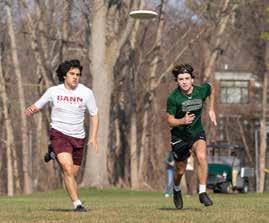

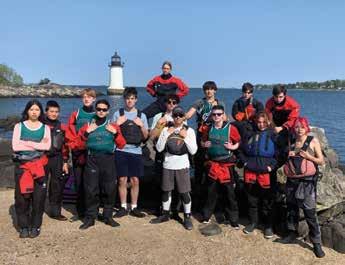

↗ In a stellar season, the girls Alpine skiing team led the CMSL standings from start to finish, earning both a team and individual championship before finishing fourth at the NEPSAC tournament with another individual title (page 13). The boys Alpine skiing team also enjoyed success, finishing second in the CMSL, with two skiers earning all-league honors.

→
In the second annual Spring Cup event in April, at rival Bancroft School, the baseball, tennis, and lacrosse teams successfully defended last year’s inaugural victory, winning four out of five contests and keeping the cup!



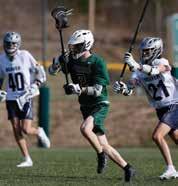

→
The girls and boys track and field teams each took second in the EIL championship. With 34 athletes scoring points and four individual EIL champions, CA had the highest combined point total of all EIL schools competing. At the NEPSAC championship meet, CA athletes set more than a dozen personal bests and three school records, and the boys 4x400 team won CA’s first NEPSAC relay title.

→
The boys varsity tennis team captured the EIL championship for the second year in a row. Finishing as the runner-up in the Class C NEPSAC tournament capped off an impressive two-year run of excellence.
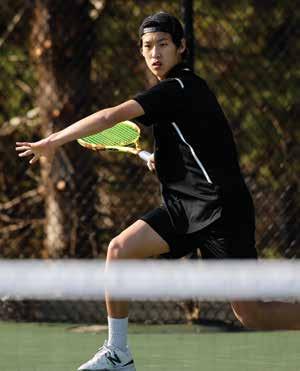
←
On the strength of its 9–1 season record, the girls varsity tennis squad earned a No. 2 seed to the Class C NEPSAC tournament, its sixth consecutive bid, with a resounding 5–1 victory in the quarterfinals.


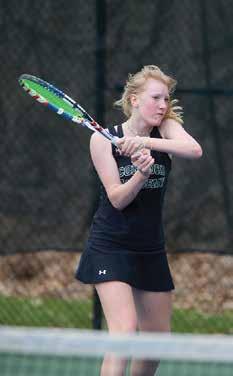


On a cool, misty spring morning, Henry Fairfax was installed as Concord Academy’s 11th head of school. The ceremony took place in a fitting location: on the basketball court in the Student Health and Athletic Center. “Backboards, orange rims, and that ball quite literally opened the door to my independent school journey, so there is not a better setting for me to share my story than in a gym,” Fairfax said in his remarks.
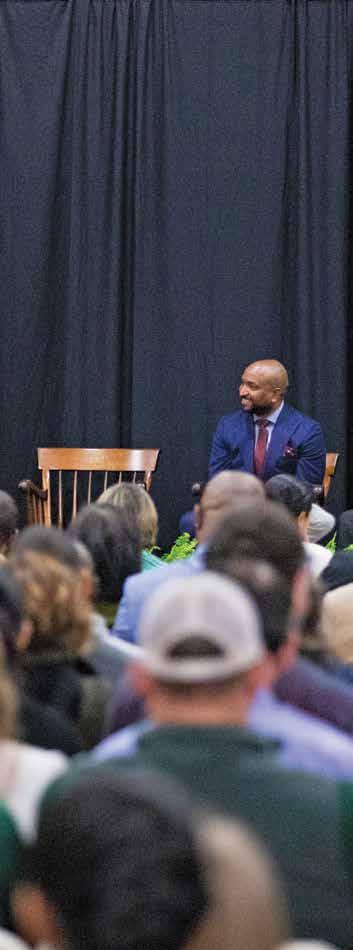
The May 4 event began with a student performance of Stevie Wonder’s “Living for the City,” led by vocalist and guitarist Andrew Wood-Sue Wing ’25. Fay Lampert Shutzer ’65, president of the Board of Trustees, greeted the more than 600 students, faculty, staff, trustees, former board presidents, the extended families of Fairfax and his wife, Ivy, and a number of Fairfax’s mentors. She commented on the work ethic Fairfax showed immediately upon his appointment, citing his mantra for moving the most important work forward. “He is ‘running but not hurrying,’” she said.
Community and Equity student representatives Aisha Aina Tasso ’23 and Kadija Bah ’23 took the podium next. Both students of color, they noted that places like CA were not designed for people like them. Aina acknowledged that while Fairfax can’t yet fully address that reality, “what mattered to us was not that he has all the answers to our concerns, but rather he affirms to us that he cares about our experiences and the stories we told.”
Kadija added that Fairfax moved his office to be closer to students
and connect with them. “Henry’s thoughtfulness and kindness don’t go unnoticed by the CA community,” she said. She also appreciated that Fairfax is not just committed to striving for equity, but is ready to “run toward it.”
In her address at the event, English teacher Sabrina Sadique shared that she had been honored and excited to be part of a group that updated the CA mission statement, and to ensure that equity was included. She recalled the virtual Commencement of 2020, four days after the murder of George Floyd, and said that shortly afterward, still during a time of “unimaginable continuity of losses,” a search committee was formed to select CA’s new head of school. Sadique, a member of the committee, said Fairfax revealed in early conversations that “striving for equity” was the part of the school’s mission that drew him to CA.
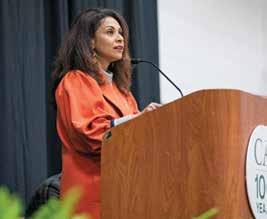
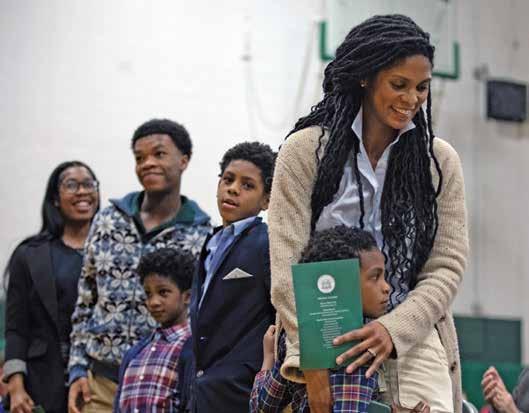
“Implicit in striving is not merely the imperative for ceaseless renewal of action, but also our transcendental capacity to keep fighting in the face of failure,” she said. “And to struggle, as I know it, is the kiln that forges self-knowledge—the very condition that dazzles our blind spots into light.”
Guest speakers at the installation included Tom Wilcox P’01, who served for 19 years as CA’s eighth head of school. Wilcox has known Fairfax since 2005, when Fairfax was the director of the Foundations Program at the McDonogh School in Baltimore, an institution that identifies and supports first-generation students and families at independent schools. “You should know that nominating Henry to be your head was one of the greatest moments in my life, surpassed only by him telling me that he had indeed been asked to serve our school,” Wilcox said.
Fairfax’s best friend, Ashley Howard, an assistant basketball coach
at Villanova University, also spoke. He told the story of how he and Fairfax met on a basketball court at camp in 1993. They both love basketball and have played thousands of hours together—including when they were both students at Drexel University—over the last 30 years. “Henry and I care about a lot of the same things: equity, providing access to education, and recognizing the pain and joy of being part of a great team,” Howard said. “We care about making an impact on those around us. … I’m honored to have a person of Henry’s integrity, energy, and wisdom as my friend.”
Fairfax himself was the final speaker of the morning. In his remarks, he shared his love and appreciation for his family and friends in attendance as well as his appreciation for the CA community. “CA and I share something in common,” he said. “We were both raised and heavily influenced by strong women.”
He also issued a challenge to think beyond what he considers a false dichotomy between competitive spirit and the school’s cooperative ethos. “Competition and humility do not have to be in conflict or paradoxical concepts,” he said. “CA family, I’d like for us to work together to find the intersection of humility, collaboration, and vigorous competition. I believe these ingredients breed champions.”
Most importantly, he said, “I want everyone in this room to know that it is my mission to make sure that every person connected to the Concord Academy community feels like this is their home.”


Fairfax also circled back to the installation’s theme. “I intend to make sure that striving for equity and honoring the individual occur in perpetuity,” he said. “However exhausting, uncomfortable, and humbling that work might be, it is who we are and it’s part of our institutional superpower.”

LEARN MORE Watch the ceremony at concordacademy.org/installation.
I want everyone in this room to know that it is my mission to make sure that every person connected to the Concord Academy community feels like this is their home.”
—HENRY FAIRFAX


MORE THAN 600 COMMUNITY MEMBERS came together at Concord Academy between June 9 and 11 for a momentous occasion: the final and largest of several observances of CA’s 100th anniversary. The Centennial Celebration invited guests to consider their place in CA’s history as well as the school’s role in building a more just and sustainable future. Balancing thought-provoking discussion with plenty of opportunities to mingle, the weekend turned out to be one heck of a party as well as a tribute to the power of a CA education.
STORY BY HEIDI KOELZ PHOTOS BY COLE AND KIERA PHOTOGRAPHY, JODI HILTON, AND NICHOLAS PFOSIlasses celebrating reunions enjoyed special dinners, and alums, faculty, staff, and parents from different eras had an unprecedented opportunity to connect with each other. A decade-bydecade archival display and an oral history video project got guests reminiscing. In the Math and Arts Center, artwork by current students and alums was on view. Some guests borrowed canoes to paddle down the Sudbury River, and others took walking tours, exploring campus or the town of Concord.
At Saturday evening’s celebratory dinner, the campus looked festive in the glow of lights and lanterns. Guests raised glasses of champagne for a series of toasts and enjoyed music performed by an alum chorus—the first ever assembled—and several other members of the CA community.
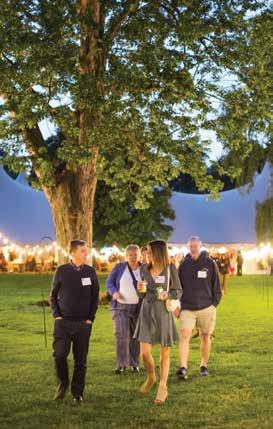
Throughout the weekend, while sunshine alternated with showers, the hallways, paths, gathering spaces, and an enormous tent big enough for all who attended all hummed with collective energy. One alum called the effect a “fountain of youth.” >




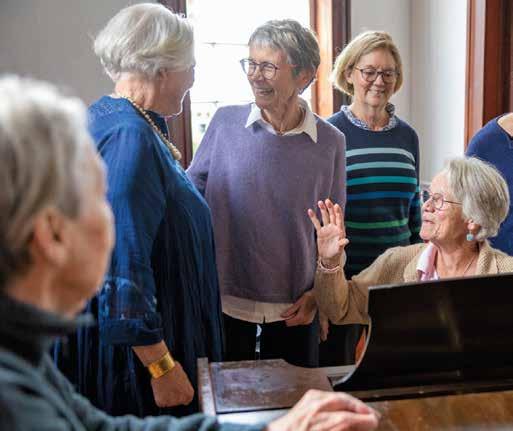
We’re designers, we’re architects at a time and in a space where we can do something really, really magical together, and I’m looking forward to co-authoring that.
<< HENRY FAIRFAX , Head of School
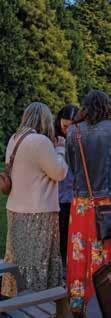

In true CA spirit, the program within this celebration of community centered the perspectives of many individuals. Nearly 30 alums lent their voices to “CA’s Mission in Motion: Centennial Speaker Series.” Scientists, artists, activists, writers, public servants, educators, academics, entrepreneurs, and more, they offered powerful reflections on creating positive change. Over four hours of community dialogue, it became evident that love of learning, that hallmark of a CA education, lasts a lifetime.

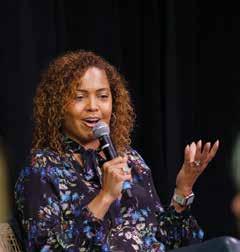
The opening session, “The Power of Personal Stories,” engaged some of CA’s celebrated authors in conversation with moderator Lucille Stott, former faculty member and administrator and author of CA’s Centennial book, Concord Academy at 100: Voices from the First Century Drew Gilpin Faust ’64, historian and president emerita of Harvard University, reflected on the role stories play in providing role models and in shaping a world we want to live in, as well as CA’s part in her own life story, which she has chronicled in a forthcoming memoir. Biographer David Michaelis ’75 spoke about the importance of being able to “live in strangeness” and to inhabit the mind of another, and how his most recent subject, Eleanor Roosevelt, “found her humanity in others.” Princeton professor and National Book Awardwinning author Imani Perry ’90 shared her drive to make a “resourceful, creative story to do justice” to her subjects, from playwright and activist Lorraine Hansberry to the Black national anthem, “Lift Every Voice and Sing.”
In the six moderated conversations that followed, alums considered topics including journalism’s role in democracy; essential perspectives from women in entertainment; changing systems for resilience and sustainability; artistic models for transforming cultural understanding; improving the human condition through science; and empowering communities for social progress. >

This school was absolutely essential for my having been able to live the kind of life that I’ve been blessed to lead.
DREW GILPIN FAUST ’64 >>
The challenge for women remains having that courage to speak your truth. You’re not here to maintain the status quo. You’re here to change the game for the next generation.
<< DANIELLE LEE ’93
That's the lesson of life stories—that you are who you are because of who everybody is.
<< DAVID MICHAELIS ’75
Art and justice are about looking at something that doesn’t exist … and imagining something that can be there, and then working to make it so.
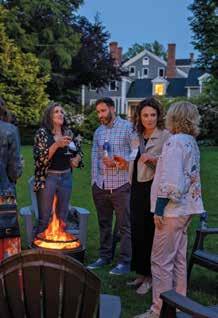
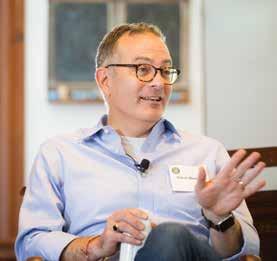




I choose stories that I think need to be told, and I’m sort of struggling with why they haven’t been told yet.
<< IMANI PERRY ’90
CATHERINE GUND ’83 >>
The world needs CA alums now more than ever.
AMY CAMMAN CHOLNOKY ’73 >>
One of the things I love is that I am both a clinician—I get to be goofy with kids—and I get to be a researcher. PETER DE BLANK ’92
In the closing session, “The Future of Education,” moderator Trelane Clark ’92, P’22 framed the conversation around “educating whole human beings.” Head of School Henry Fairfax spoke about CA’s future in light of its origins as a girls school, part of the women’s equality movement. “I find that we are uniquely positioned to do something really significant,” he said, and he emphasized the work that lies ahead in CA’s commitment to striving for equity. Researcher, policymaker, and strategist Turahn Dorsey ’89 proposed reengineering independent schools “for public purpose” and shared hopes that CA would nurture young people as “agents for justice” and create “communities that lift everyone up.”

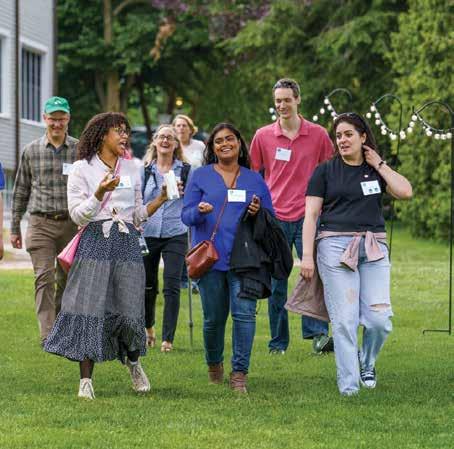
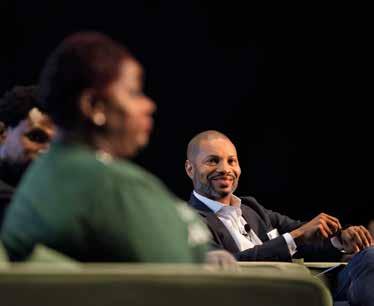
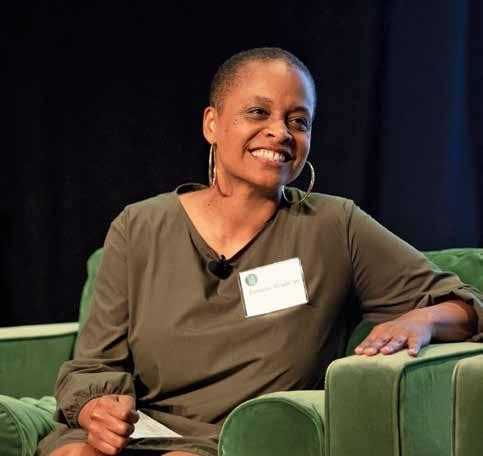
I do think government works, but I think our approach has to be about collaboration.
<< TREMAINE WRIGHT ’90LEARN MORE See videos and photos and read more at concordacademy.org/centennial-celebration.
You have to renegotiate privilege to do equity well.
TURAHN DORSEY ’89

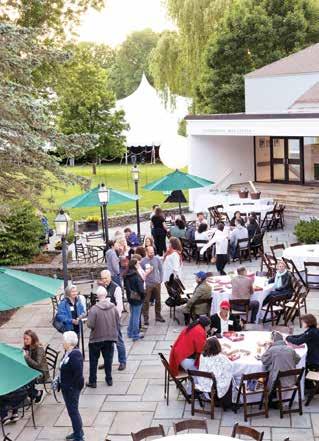

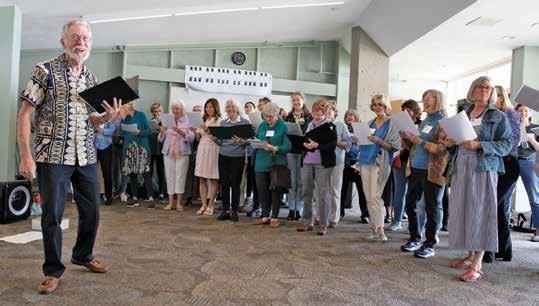

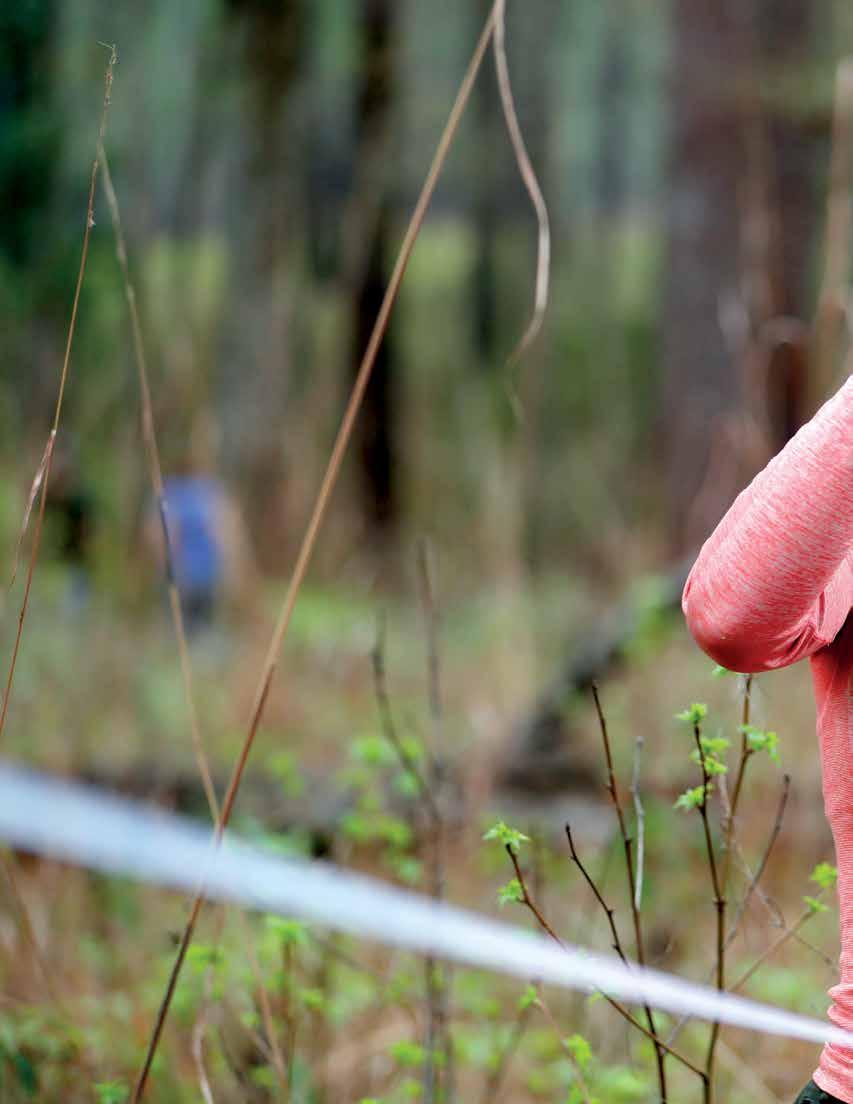
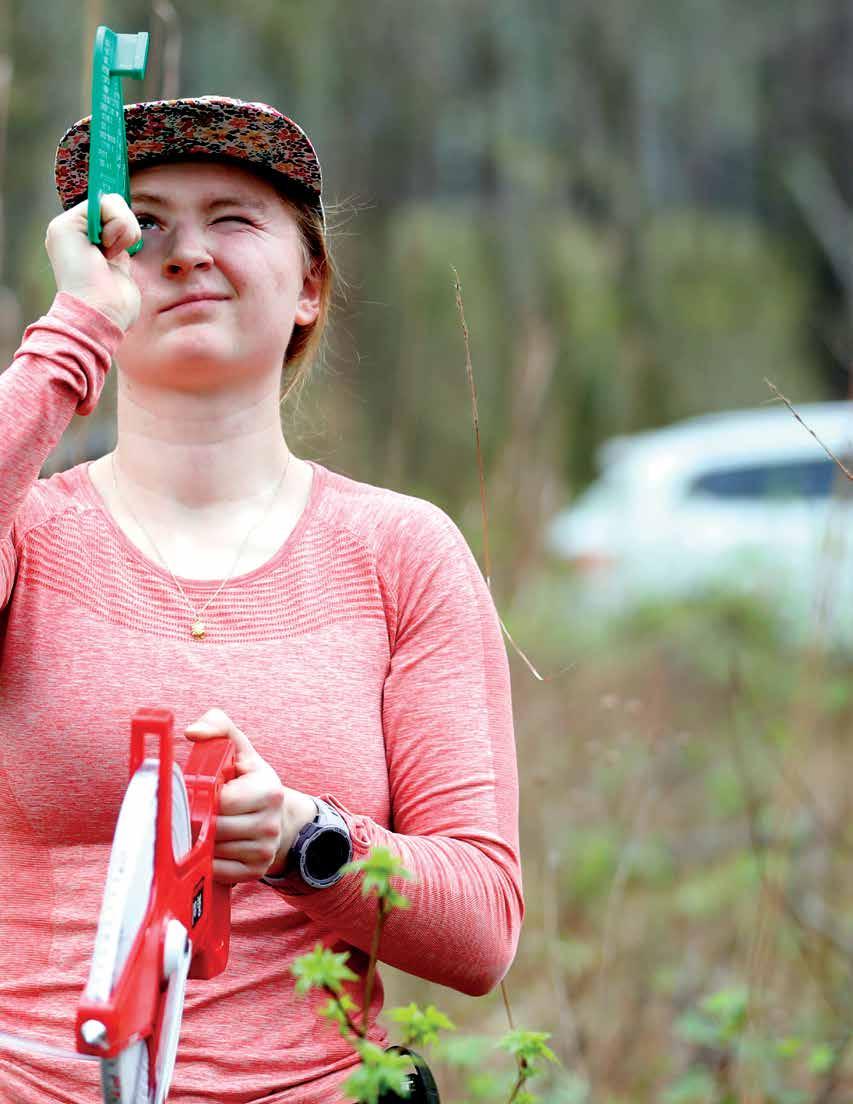
Studying old-growth longleaf pines in Georgia, CA students discover more than meets the eye
“Fire creates its own weather if it’s big enough,” their guide, Paul Massey, told them. “This was one year rough, and you see how it’s goin’ up.” He gestured to where the flames, converging from two directions, were flaring high and orange.
Massy has overseen this springtime ritual in Georgia for four decades. At Arcadia, a private land preserve near Thomasville where he is the property manager, he burns up to 200 acres at a time, the blazes bounded by dirt roads and by firebreaks dug with a harrow and a tractor. The longleaf pine forest native to the area doesn’t just tolerate fire, it thrives on it. Potash from the fire acts as fertilizer, and every species in this habitat relies on the conditions created when the understory is scorched.
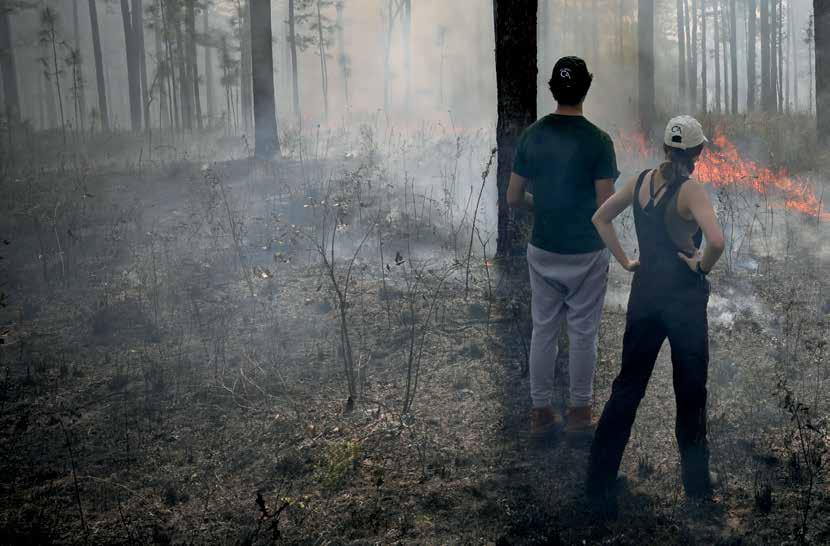
The opportunity for students to experience this ecosystem—once dominant
but now exceedingly rare—came through a Concord Academy connection. Jamie Wade Comstock ’82, P’17 invited five CA students, selected from a strong pool of applicants, to come to Arcadia the week before spring break, along with trip leaders Gretchen Roorbach P’17 and Jodi Pickle. Thanks to a grant from the Wade Family Foundation, the group received an all-expenses-paid trip from Massachusetts to Georgia to conduct scientific research.
Comstock, the students, and the teachers followed the fire for a good hour. “It’ll burn ’til dark,” Massey told them after a while.
“You can stay and watch it,” he added, heading for his truck. Burn-off is business as usual in the Red Hills region near Thomasville, and the students had been hoping the weather would allow them to experience it up close. On the short flight from Atlanta

BEHIND
FIRE LINE, pine cones the size of footballs smoldered on the blackened ground. Every step crunched. Some of the students observing the controlled burn turned up the soles of their boots to check if they were beginning to melt. Up close in the sizzle and smoke, it was startling how suddenly a light breeze could lick up the blaze.Top: Ishaan Jain ’24 and Lucy Baker ’23 observe a controlled burn at Arcadia in Thomasville, Ga. Top Inset: CA students at the burn: Maya Khalil ’23, Phoebe Fritz ’23, Ishaan Jain ’24, Lucy Baker ’23, and Annie McGarry ’23. Right Inset: Jamie Wade Comstock ’82, P’17.
to Tallahassee, Fla., an hour’s drive south, they had glimpsed hundreds of controlled fires—from the air they appeared like wisps of clouds rising from the woods.

They weren’t disappointed. “I was mesmerized,” Lucy Baker ’23 said. With family in Colorado, she understands the havoc wildfires have wreaked in the American West. “I’ve never seen fire like that in such a positive way,” she said.
The students had come to study an old-growth area at Arcadia known as the Wade Tract Preserve. To understand its uniqueness, they first got their bearings by learning the history of the region, exploring other parts of the forest, and enjoying Comstock’s Southern hospitality.
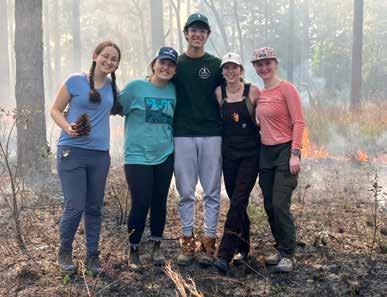
The evening they arrived, she invited them to the low-slung midcentury house her family also calls Arcadia. To reach it, they rode three miles along dusty red-clay lanes through open woods, past a few fields, and, finally, up a steep,
root-gnarled track. The house sat high on a small plain, from which mown grass footpaths meandered downhill to two human-made ponds. A bright green Kawasaki 4x4 was parked out front.
Comstock came out to greet them, barefoot in the warmth of March in southwest Georgia. In the late afternoon sun, dogwoods glowed gold on the lawn. The patio was the perfect perch for taking in the landscape: low, rolling hills with sun-flooded pine woodlands, perfectly straight trunks as far as the eye could see.
“I feel a lot of love for the environment here,” Comstock said, ushering the students inside. She opened several sets of sliding doors, turning the brickfloored living room into a breezeway. “I hear so many animals.” Indeed, she later pointed out the croaks of lizards— they’re known to get into the house— and the yips of distant coyotes.
The land that makes up Arcadia had once been part of the neighboring family property, Millpond, more than 10,000
acres Comstock’s great-grandfather Jeptha Homer Wade II had accumulated in parcels by 1906. Like many prominent Cleveland families wanting to overwinter in a milder climate, the Wades had been drawn to the area in the late 1800s, when a resort industry developed around Thomasville, the last stop on the southbound rail line. Initially they managed the property for hunting, with prescribed fires creating conditions ideal for the region’s all-important bobwhite quail (a painted wooden replica took pride of place on the mantel).
Comstock said her parents, Jeptha H. Wade III and Emily “Paddy” Vanderbilt Wade, took on “this third of Millpond to manage differently,” for conservation, in the mid-1970s. “Arcadia was most famous for my mom’s determination to farm organically in the 1970s,” Comstock said. “Now it’s all about longleaf.”
There are similar land tracts in the region, most still in the hands of families from Cleveland. “Many are very conservation-oriented, even if they do privilege the quail habitat,” Comstock said. But at Arcadia, management took a different turn.
In 1961, the biologist Herbert Stoddard wrote to the Wade family to testify to the uniqueness of several hundred acres at Millpond, having never
been discernibly logged, “hence in my opinion so valuable for research that none of us living today can foresee all the values the block will have for generations to come.” In 1979, Comstock’s parents formally protected the area Stoddard had identified—what became the Wade Tract—granting a perpetual conservation easement to Tall Timbers Research Station and Land Conservancy. It was the first such conservation agreement made in Georgia. In 2013, the Wade Tract was designated a National Natural Landmark, the best remaining example of the oldgrowth longleaf pine savanna that once blanketed the southeastern United States.
Today longleaf is one of the rarest forests in North America. Once covering 90 million acres, from Virginia down to Florida and west into Texas, now it’s limited to only 3% of its former range, and most of that is in young, reestablishing forests. These days, setting foot on longleaf habitat that has never been disturbed is an experience of a lifetime.
The day after Comstock’s warm welcome, Massey gave the group a tour of the northern section of Arcadia. Near the house, most of the trees were loblolly
pines. “These are around 200 years old,” Massey said casually, with the timing of a seasoned raconteur. “They max out any longer than that. Not like longleaf, that can go on forever.”
Driving some students in his pickup, with others following in the Kawasaki and staying in touch by phone, he described the landscape as they bumped down the dirt tracks. Butterflies and dragonflies surfed the air currents beside the truck, and with the windows down, a fine dust drifted in.
“That’s a kingfisher, you hear him?” Massey called out.
He pointed to areas of low-growing young longleaf pines—they stay in the

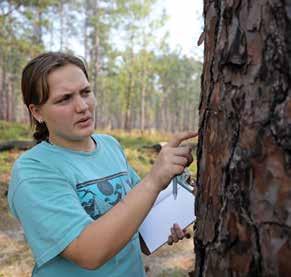

grass stage up to 10 years while setting down taproots—as well as taller stands, which he explained would thin over time. Longleaf needs sunlight to generate; to prioritize its habitat, Massey said he gradually expands natural openings in timber stands. Throughout the forest, fire had blackened the base of every tree trunk.
As they rode, students and teachers peppered Massey with questions. How old were these trees? Most were between 150 and 350 years old, older still at the Wade Tract. And at Greenwood, a nearby site that Paddy Wade had purchased in 2015 to protect it from development, the oldest tree was pushing 700. How
unusual was this land? “Like hen’s teeth,” Massey replied. He takes pride in maintaining the forest as he’d first seen it. “My job is to save trees, not cut trees,” he said. “The problem they seem to have lost sight of is that it takes 200 years to grow a 200-year-old tree.”
When they came to a muddy puddle near a rivulet, Massey stopped the truck and got out to clear fallen branches from the road. The group got out and gathered where he pointed out the tracks of wild boar and noted how the landscape was transitioning. In this ecotone, longleaf pine gave way to pink-blooming redbuds, an aged oak draped in Spanish moss, and a crowd of ferns. In a low area nearby, Roorbach had the students pick out plots to analyze the next day, to compare measures of biodiversity against samples they would later collect at the Wade Tract.
The following morning dawned muggy. Birds called and answered each other in the forest. The students retrieved their instruments, field notebooks, and kit from the back of the Kawasaki, then marked out two 10-meter plots. It was tiring work in the heat amid the thick growth.
Bent over a field guide, Maya Khalil ’23 tried to identify a fern growing by the road. “I want to see the spores of the fertile fronds as they’re developing,” she said, and she clipped a field microscope to her smartphone.
Ishaan Jain ’24 struggled to take a core sample, vigorously twisting the drill but only succeeding in inching it into the ground. Thinking he might be hitting a root, he moved over, but it was still slow going. Eventually, he deposited the sample onto a tray—a couple of inches of loose topsoil, the rest compacted clay. Roorbach called the group over. “Look!” she said. “Here’s the classic Georgia soil profile.”
The students centered their plots around the thickest vegetation, hoping the dense underbrush would offer more species to observe. They set about



creating overhead canopy maps and vertical structure diagrams and establishing a biodiversity index. They used purple eyeglasses to detect stressed plants, checked the pH and moisture in the soil, and measured wind speed, temperature, and relative humidity. Phoebe Fritz ’23 settled herself on a log, a birding app’s sound identification visualization spooling across her phone screen, highlighting in turn the song of a Carolina wren, a blue-gray gnatcatcher, a redwinged blackbird.
Pickle rekindled the excitement of her earlier days in the Science Department, happy to be back in the field. “You can recognize how quickly it’s regenerating,” she said— though the area had been burned some six weeks earlier, it was lush and green. She began looking for the source of the sand they’d noticed nearby. The plant density increased near the only place they had seen limestone.
“It won’t start growing significant pines here,” Pickle said, theorizing about the soil and the bedrock beneath as she roamed.
The observation of erosion drew Annie McGarry ’23 over from the research plot, where she’d been squinting along a tree height gauge. At the
dirt road, she and Pickle started turning over rocks and found, surprisingly quickly, a number of fossils: crinoids, coral polyps, a slice of clamshell.
“No way!” Annie marveled. “It’s literally the more you pick up, the more you see.”
“That’s the way life is,” Pickle said. Everything, she suggested, provides clues about its origins. “Isn’t it amazing to learn to read the landscape?” she asked. “You start asking, what am I noticing? Also, what’s not here?”
The following afternoon, when the group took its long-awaited tour of the Wade Tract, some of the students were initially surprised to find that in this highly studied 200-acre plot, every tree was tagged. They had learned that longleaf-dominant forests are some of the most biologically diverse in North America, but it was a challenge to see how that could be. Tall, slim pine trunks stretched up over 100 feet. Trees were spaced widely with an open canopy, little brush, and no low-growing branches. Compared to New England, these were minimalist woods. Someone called it an enchanted forest: It looked like it belonged in a fairy tale.
“It’s hard to explain to my friends up north,” Comstock said. “It doesn’t feel closed-in.” She had come along for a
talk with Jim Cox, the site coordinator and director of Tall Timbers’ Stoddard Bird Lab, who has conducted research there for decades.
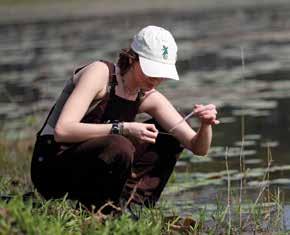
Tall and slim, Cox was soft-spoken. His love of this environment needing no emphasis, he narrated quickly and with ease. As they moved through the open woods, he invited the students and teachers to notice how their heels sunk into the humus. “These are virgin soils, and you won’t find this anywhere agriculture has been prevalent,” he said. “There’s an entire two feet of what we call the ‘A horizon’ before you get down to the clay soil.”
He recalled coming to the tract the day after a hurricane. “You’d think there’d be all this water sloping off this hill,” he said. “No, it was all going in.”
If witnessing a prescribed fire was the dramatic highlight of the trip, walking through uncut forest was a less dramatic, but deeper experience. Taking it in seemed to require a different kind of
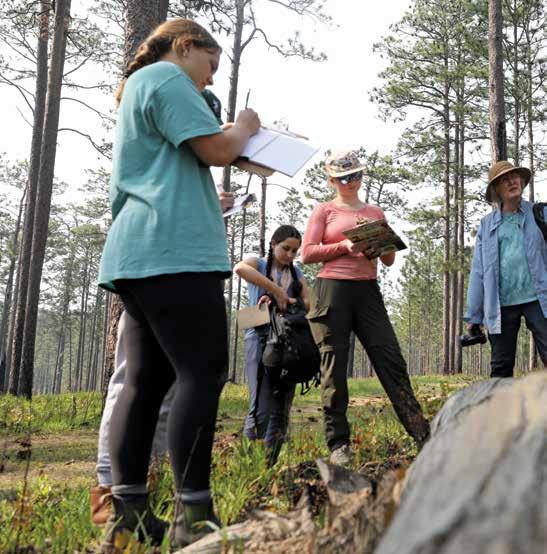
vision: seeing below the ground, and on a more-than-human timescale.
“It’s very beguiling,” Cox said a little wistfully. “It’s very simple looking, but it’s not.” At ground level, he explained, more than 50 plants could grow in just one square meter. And the forest is home to several species that depend on old-growth trees and regular fires, such as the endangered red-cockaded woodpecker—with a bird whistle, he drew out five that flew from a nesting cavity high overhead—and the declining Bachman’s sparrow and brown-headed nuthatch. Another fire-tolerant species, ground oak, sprouted up in many places; its root systems are connected underground, and what appeared to be a little shrub could have been a century old.
Pocket gopher mounds rose above the soil, and gopher tortoise burrows vanished below. A “keystone species,” on which others depend, the tortoise has an outsized impact on the ecosystem. More than 200 other species use
its burrows, including some that are found nowhere else.
“What I like about this animal interaction, with the soil, with the fire, with the way the plants grow and develop— it’s a triangle,” Cox said, pointing to a burrow’s entrance, where new longleaf were sprouting in the only place they can: bare soil. The subtle disturbances the tortoises create—kicking up sand while browsing for vegetation—clear the area of pine needles (“one of the most volatile fuels out there, tons of terpenes,” Cox said). That helps establish the oaks, which grow quickly, until eventually the longleaf pines overtake them. When it becomes too shady, the tortoises move on—clearing another area, and readying it for more longleaf. This self-regulating cycle plays out over some 200 years.
A longleaf grows straight and tall for 80 to 90 years, before it can no longer pull nutrients up the height of its trunk and it starts growing laterally. “They get
this bonsai look,” Cox said of the older trees, whose upper branches resembled the curled pine boughs in a Japanese painting. Most longleaf pines continue to age until, usually, they are killed by lightning strikes.
“There’s a 500-year-old tree here,” Cox said quietly.
“Oh, can we go?” Lucy asked.
“I mean, yeah, it’s right down here.”
“Let’s go!” Annie hollered, charging ahead.
The students touched its deep-fissured bark reverently. “Let’s think, guys,” Annie said. “This tree was here when Christopher Columbus came to the Americas.”
The light had gotten long from the west. Each straight trunk became a sundial.
“I can’t really wrap my head around the fact that this has never been disturbed,” Maya said.
“Luck has given us this place,” Cox replied. The train arrived in Thomasville the very month federal troops were fired upon at Fort Sumter in 1861, he explained: Five to eight years later, “we’d have had great transportation for carrying cotton to market—and Arcadia would have looked like the rest of the Southeast, totally turned over to agriculture.”
Before parting from the group, he put the tract’s rarity into perspective. By one estimate, only around 1,200 acres of longleaf pines, out of the original 90 million—or .014%—is uncut oldgrowth, Cox said: “It’s like the world’s population being whittled down to the size of Cleveland.”
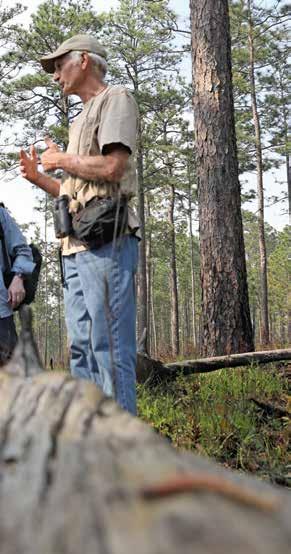
On the final morning of the trip, the students journaled in the woods. “I was surprised by how sparse the vegetation was,” Phoebe wrote. “While I know that the biodiversity here is most likely similar to, if not greater than, the biodiversity at the first plot, the understory and brush in the Wade Tract were far less prominent.”
Lucy recalled her first impressions of Arcadia. “It smells so insanely good here. It’s sweet and smoky and humid,” she wrote. “I was surprised by the openness of the forest, the red soil, and how high up the crowns of the trees are.” Others reflected on data that documented the diversity and stability of the Wade Tract.
For her part, Comstock was happy the students had been able to take it all in. “I’m very proud of this place and glad this trip was a success,” she said, “so more CA kids can keep coming to the Red Hills region.”
JAMIE WADE COMSTOCK ’82, P’17

The Concord Academy Centennial Campaign is our great opportunity to celebrate CA’s role in shaping the lives of young people. Across generations, our graduates demonstrate over and over that those who live and learn at CA develop into forces for good, magnifying this school’s impact in the world. We must continue to serve and encourage all of our students, and to see them for who they are and who they can become. This is our charge and our joyful responsibility.
CA’s Centennial Campaign, with a goal to raise $50 million+, is an investment in the future of this school and in the dreams and aspirations of our students. Our priorities are in service of an institution dedicated to relational learning, equity, common trust, and honoring the individual.
Our community members have embraced their role as stewards of this beloved institution; many have already stepped forward to bolster the school with unprecedented conviction.
$25 MILLION+ (goal)
A plan decades in the making is now coming to fruition. Over the summer, site preparations began for the Centennial Arts Center, a bold and significant expansion of CA’s space for creativity and collaboration, and work is continuing apace. The creation of a true West Campus surrounding this new building will reshape 40% of CA’s learning environment for the benefit of all students. With successful campaign completion, we anticipate opening the new building in 2025.

$25 MILLION+ (goal)
A strong endowment is vital to ensure CA’s ability to remain student-centered in every aspect of its program. Endowment growth is CA’s long-term answer to the promise of equity for all students, regardless of their economic circumstances. We believe CA must continue to be a magnet for the very best educators, and we must secure the resources to increase access for students from every background.
As of June 30, 2023, 220 donors have given $41.8 million toward our $50 million+ goal. In these final months of the Centennial Campaign, each and every contribution will help determine CA’s future.
To learn more about opportunities to join this historic effort, please visit concordacademy.org/ campaign or contact Alice Roebuck, assistant head for advancement and engagement, at alice_roebuck@ concordacademy.org.
concordacademy.org/campaign
Many members of the CA community have been moved to invest in Concord Academy’s future, affirming the school’s importance in the world. Their contributions are helping CA grow its endowment, improve its campus, and invest in new possibilities for learning. These valued supporters share why they made donating to CA’s Centennial Campaign a priority.
As an international student, Humphrey Lee ’00 appreciated that CA ensured he felt at home on campus. By valuing cultural differences, he says, the school “promoted an environment that enabled a smooth transition for non-natives coming into the community.”
Lee recently made an unrestricted gift to the Concord Academy Centennial Campaign to support CA’s “continued focus on academic excellence, its founding commitment to diversity and cultivating a community of belonging, and its open and collaborative culture,” he says. “I am eager to see the school thrive and continue to have a positive influence on more and more students.”
Lee earned a bachelor’s degree in economics in 2004 and a master’s degree in regional science in 2006 from Cornell University. Following summer internships at Morgan Stanley and UBS, he accepted his first job as an analyst with UBS. Not long after, he began working with a property development company in Hong Kong. “I found it very important to be able to work with people who think and act quite differently, and CA prepared me very well for that,” he says. A business manager, he currently oversees a portfolio of leasing properties and development projects across Hong Kong and China, and he is a proud father of three.

Philanthropy is one of many ways Lee remains connected to this school. “I made some of my best friends at CA and learned from some of the best teachers while studying there,” he says. “I wish CA great success for the Centennial Campaign and the very best for the next 100 years.”
When their daughter Erica Reisman ’05 was a senior at Concord Academy, Robin and Howard Reisman P’05 co-chaired the 2005 Senior Parent Gift Committee. That volunteer experience “got us thinking about CA as more than just the place our daughter went to school,” Howard says. “The school cultivated that over time and created a connection that was, and continues to be, very strong.” Honoring that connection, the Reismans recently made a generous gift to the Concord Academy Centennial Campaign to help strengthen CA’s financial foundation.

The youngest of the Reismans’ three children, Erica identified Concord Academy as her top choice during the secondary school application process. Once at CA, she loved the culture. As an athlete, “she liked the collaborative nature of the school and found everything to be more balanced than at peer schools,” Robin says. The Reismans watched Erica’s remarkable growth as a student at CA, particularly as a writer and a risk-taker. They recall a specific physics course, known to be quite difficult, that by her senior year Erica was willing to try “for the benefit of the experience,” Howard says. “Today, Erica loves to travel and try new things. That growth came from Concord.”
The Reismans fondly remember CA's strong culture of cooperation and common trust, caring faculty members, high academic standards, and diverse extracurricular activities. “We view Concord as very important and worthy of our generosity, because, simply, the school does such a great job with students,” Howard says.
Cultivating faculty excellence. Creating equitable pathways for students. Catalyzing new cross-disciplinary initiatives. Ensuring institutional stability.
By remembering CA in your estate plans, you can make an enduring investment in a transformational education and every life it touches. Join the Heartwood Society, experience financial and tax benefits for you and your family, and leave a legacy of support well into CA’s next century.
LEARN ABOUT PLANNED GIVING: Contact Shep Shepard at (978) 402-2258 or shep_shepard@concordacademy.org.
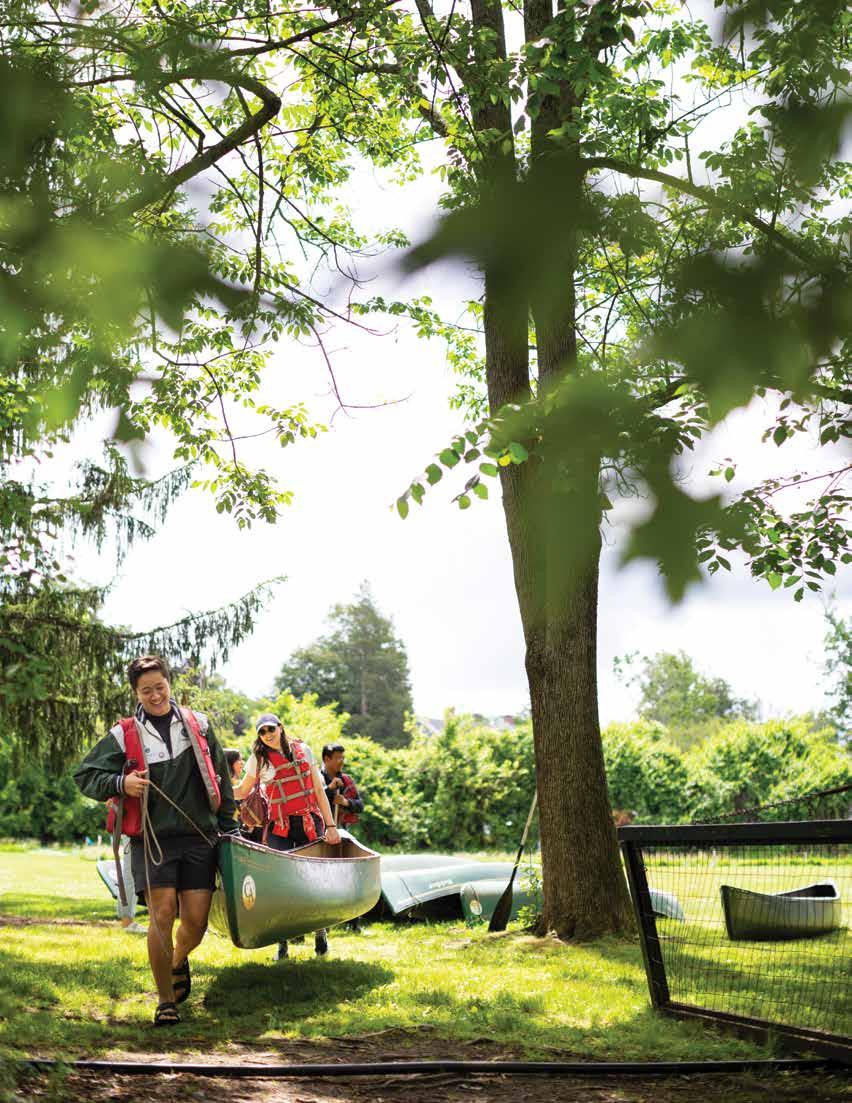
What a time this has been! In Concord Academy’s 100th school year, we reconnected with one another, reflected on our experiences, and reaffirmed the values we hold in common thanks to our CA education. And we partied. Oh, did we party! It was wonderful to see all of you who made our Centennial Celebration (page 20) creative, intellectual, inspiring, and joyful.
I am so grateful to everyone who planned and participated in the many Centennial events this spring, both on campus and across the country. After any major occasion, especially something we’ve looked forward to for a long time, there comes a pause. This pause is important to honor, even as we turn our attention to what’s ahead. At this time, we can continue planning from a place that’s a little more spacious, appreciating a little more deeply all that has gone into creating and sustaining our thriving community.
What I hope for now, as we lay the foundations for CA’s next century, is that we will use the momentum this milestone has generated to continue our engagement with each other and with this school. The beauty of this is that we can decide what that means in practical terms. What is alive for you now that you wish to reflect on, to share, to see continue, to see begin? I’d love to hear from you at ca_alum@concordacademy.org!
Your partnership is critical for CA’s next 100 years. I encourage you to offer what you can—mentorship, knowledge, connections, time—to engage with this lively, evolving community that is making a difference in our world. You might just exercise muscles, acquire skills, and embrace perspectives that are new to you if you make this part of your own lifelong learning journey. Concord Academy is not only our school but also our home. We are part of its past, its present, and its future.
Trelane Clark ’92, P’22 Alumnae/i Association President
Everyone who attended Concord Academy is automatically a member of the Alumnae/i Association, which fosters lifelong connections between Concord Academy and its global community. The association facilitates meaningful opportunities to preserve and promote a love of learning, service to others, and a commitment to diverse perspectives and backgrounds. Through involvement in the life of the school, within the community, and through service to the greater world, the association strives to renew and affirm the core values instilled while at CA.
From Friday, March 31, through Sunday, April 2, 40 alums took part in Concord Academy’s first Alums of Color Reunion. The weekend offered members of CA’s diverse community a chance to come together to discuss shared experiences, learn about the school today, and meet two dozen current students.


Throughout his first school year at CA, Head of School Henry Fairfax brought his listening and learning tour on the road. He invited the nearly 75 alums who attended events in Los Angeles, San Francisco, Chicago, and Washington, D.C., to give their perspectives as the school shapes a vision for its second century.
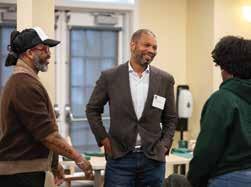

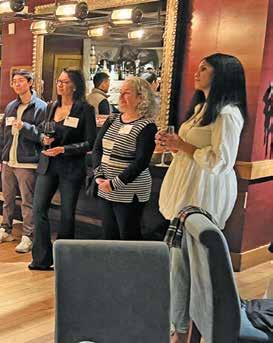
Every year, Concord Academy relies on contributions from parents and alums. The volunteers who lead the charge are some of CA’s most enthusiastic advocates. We asked Alum Annual Fund co-chairs Tess Munro Bauta ’94, P’25 and Alexis Goltra ’87, P’26 ’27 how, and why, they make the case to support CA every year.
How has it been to re-engage with CA as parents and alum volunteers? Alexis Goltra (AG): It’s been wonderful to see CA through the parent lens, knowing my kids are having the amazing benefit I enjoyed and that it’s still the same. The campus is a lot nicer, but there’s continuity in the spirit and mission.
Tess Munro Bauta (TMB): CA is the best! This school isn’t afraid to allow kids to grow into their own voices and address difficult topics. It’s courageous to stand by your values, and CA does that. There was no question what school I wanted my daughter to attend. I love supporting CA, and it’s easy to reach out to other alums—we’re a tightknit community.
Why do you volunteer in support of the Annual Fund?
TMB: CA is a small school. A close, relational education costs more, and it’s worth it. The Annual Fund supports literally everything that happens here, from lightbulbs to bringing speakers to campus.
AG: I had a great experience as a CA student. This is a way I can give back. By helping with the Annual Fund, every year I’m helping to advance CA’s mission, which I believe in very deeply. It’s a little selfish, too—I really enjoy working with the folks at CA and the alums I get to engage with. It’s wonderful to develop these relationships over time.
What do you wish everyone knew about the Annual Fund?
TMB: CA is not a wasteful school. It’s very smart financially. Yet even full tuition doesn’t cover the whole cost of what a student gets from CA. In order to keep this diverse community, CA’s unique and amazing programs, and our beautiful campus intact, more money is needed.
AG: While the school is also raising funds for the Centennial Campaign, I encourage people to make those contributions in addition to their annual support for ongo ing operations. Without the Annual Fund, there would be less money for financial aid, teacher’s salaries, sports, arts, and diversity, equity, and inclusion efforts—it touches all aspects of school operations. Tuition doesn’t cover costs. That can be a surprise for people, and they don’t always realize that if it weren’t for the Annual Fund, we’d lose a lot of our program and the ability to fulfill CA’s mission.
In 2022–23, the Annual Fund provided
10% of CA’s operating budget, helping to fill the $20,000 gap between a full tuition and the actual cost of educating each student.
CA’s Annual Fund is mission-critical. It’s easy to donate today:
concordacademy.org/give
“I loved hearing directly from students, and I had a chance to connect with alums that I wouldn’t ever get to see during my class reunion.”
MEISHA NEWMAN ’94
Co-Chair, Alum Community and Equity Committee
Chris Rosenberg ’86 accepted the 2023 Joan Shaw Herman Award for Distinguished Service at Concord Academy on April 21. CA’s only award, given each year to an alum, underscores the school’s mission of working toward a better world.
At the ceremony, Kate Rea Schmitt ’62, chair of the selection committee, said Rosenberg’s career as a teacher and principal in under-resourced public schools exemplifies the power of education, and the ways in which social justice is fundamental in helping students thrive.
In his remarks Rosenberg offered students inspiration for making a difference in service to others, sharing how he had set up one of the first family resource centers in his school community. “I want to build people up,” he said. “I landed on education as a vehicle for change.”

After graduating from CA, Rosenberg earned a bachelor’s degree in history, focusing on African American history, from the University of Chicago, then taught history at John F. Kennedy High School in the Bronx, N.Y. He was also a teacher and recruiter for Teach for America before moving to California to teach grades 5 through 8 in Oakland and San Francisco. For more than 16 years, he served as the principal at several San Francisco public schools, focusing on supporting underserved students who sought pathways to academic success.
A former student who is now a teacher herself recently thanked him for inspiring her life path, Rosenberg said. “Thank you for being exactly who you were, at the time, which is exactly what I needed to fall in love with school,” she wrote.
Rosenberg talked about some of the hardest aspects of working with young people who live in neighborhoods affected by gun violence. “When you work in the service of others, you hope to
contribute in some positive way to their lives, and it is gut-wrenching to speak at a young man’s funeral and know that you were unable to do anything to stop this terrible outcome,” he said.
He offered perspective to students wondering how to contribute in the world. “Spending your time serving others is challenging, tiring, and often frustrating,” Rosenberg said. “It is hard to measure your success, and oftentimes you have to admit you failed, and the consequences of those failures are quite high. But the rewards are also tremendous. I also know that those people I have served have changed me and helped me become a better human being.”
The Joan Shaw Herman Award for Distinguished Service was established in 1976 to honor Joan Shaw Herman ’46, who was paralyzed after contracting polio the summer after her graduation. Although confined to an iron lung, she worked constantly to improve the lives of people with disabilities. Each year, Concord Academy recognizes a member of the alumnae/i community with this award for service to others.
LEARN MORE
Read more about Herman and this award at concordacademy.org/jsh-history.
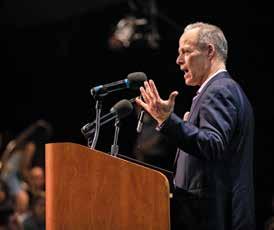
“What happens when we die?” asked 2023 Centennial Hall Fellow Sebastian Junger ’80 during his lecture at CA in May. “Why do dying people see the dead? This is one of the things only the dying seem to know.” He said hospice workers frequently mention how talkative people are when the end is close— and that they often are speaking to unseen people from their past.
Junger’s upcoming book is about neardeath experiences. The bestselling author of The Perfect Storm, Fire, A Death in Belmont, War, Tribe, and Freedom, he is also the celebrated director of several documentary films, including Restrepo, which broke ground in war reporting, was nominated for an Academy Award, and won the Grand Jury Prize at Sundance, and Korengal, about the war in Afghanistan.
Junger said he became interested in the subject of his current project for several reasons. As a war reporter, he was nearly killed multiple times, and his best friend, British photographer Tim Hetherington, died from injuries he sustained while covering the civil war in Libya—an assignment Junger was meant to be on as well. After he left war reporting, Junger experienced an undiagnosed aneurysm in his pancreatic artery. The doctors expected him to die, and Junger, who is an atheist and “definitely not a mystic,” he said, spoke with his deceased father, who comforted him. Shaken by the experience, he later thought to himself, “You were allowed to go right to the precipice, the threshold. What did you learn?”
“Think about how amazing life is,” Junger told CA students. “You get to love other people, and that’s the deal of the century.”
Junger said horrific events and war do not necessarily cause mental health struggles
for soldiers and others impacted by them; rather, those struggles are often the result of the alienation that comes afterward. During crises, he said, mental health actually often improves because of a positive tribalism that comes from relying on others.
Speaking of the generosity he witnessed in combat, Junger shared what he called two great human truths. First, he said, when we act collectively, centering the good of others, it is good for us. Second, courage works— the size or the strength of an army does not always determine whether it succeeds.
As a contributing editor to Vanity Fair and as a special correspondent for ABC News, Junger has covered major international news stories and has been awarded both a National Magazine Award and a Peabody Award. Throughout his career, he has created powerful, emotionally compelling, and vivid portrayals of the impact of war and all its heroic, disturbing, and life-affirming contradictions. His recent works examine the tension between individual freedom and community, and the conditions that create belonging. Junger is also the founder and president of Vets Town Hall, which encourages veterans to share their stories of service to their country within their communities.
Junger said that, ultimately, there are no brave people and no cowards—there are people who make choices. “Keep your eyes open and your heart open,” he told the CA audience.
For six decades, to honor the legacy of former headmistress Elizabeth B. Hall, CA has awarded the Hall Fellow Endowed Lectureship to a wide array of accomplished individuals. Each speaker brings a unique perspective to the school and exemplifies CA’s core values and mission.
CA celebrates the legacy of outgoing Board of Trustees president Fay Lampert Shutzer ’65
Sometimes the right person comes along just when they are needed most. So it was that Fay Lampert Shutzer ’65 was at the helm of the Board of Trustees during an unexpectedly trying time, in the lead-up to Concord Academy’s most historic year.
“Something special is going to happen,” Shutzer told CA Magazine in 2018 as she began her tenure as president, having already served more than 10 years as a trustee. “We’re part of figuring that out. That ability to support our kids and inspire them—that’s why we’re here.”
Shutzer had anticipated CA’s approaching Centennial, but little could she, or anyone, envision what else lay in store. Two years later, she began steering the school through the turbulence of the COVID-19 pandemic, then a leadership transition, an interim period, and a head of school search. Throughout these challenges, she was imperturbable. She guided the Board and school leaders to consensus around complicated issues— asking probing questions, listening, and balancing disparate views with empathy and compassion.
“Her love for CA is so clear,” says Jennifer Pline P’13 ’15, who along with Jen Burleigh ’85 assumed the co-presidency of the Board of Trustees on July 1. “As a collaborative leader, she had an amazing way of framing a conversation and helping us focus on the key issue at hand.”
“Fay has been an extraordinary leader during an extraordinary time for CA,” Burleigh says, citing her positivity, enthusiasm, and “rare ability to connect with others and make them feel heard.” Through the stresses of uncertainty, she adds, “she kept the Board grounded and calm, always focused on the best immediate next steps without ever losing sight of the mission and CA’s bright future.”
“It felt as though she was able to hold the entire institution at once in her gaze,” says Kerry Hoffman P’14 ’20, trustee and former CA Parents president. “She kept every constituency in mind but instinctively knew where and when movement needed to happen.”
“Fay’s natural temperament is inclusive,” says Kevin Parke P’12 ’15, vice president of the Board. “She really delegates and respects delegation, and she gave the Board an opportunity to see how new leadership could develop.”
During Commencement on May 26, in her final address as president, Shutzer said her interest in group dynamics took root at CA. A boarding student from Topsfield, Mass., she first encountered concepts in developmental psychology and personality theory in a course about community service. Soon afterward, she took a risk with her term paper for a chemistry class, choosing to research the chemical basis of schizophrenia. The school arranged for her to have access to the Harvard Medical School library. “My passion, like so many other CA students’, was no problem for our faculty,” Shutzer said in her speech.
Her teachers’ encouragement led her to become a teacher, then a school psychologist, and later a psychologist in private practice with children, adolescents, and families. At CA, she also laid the foundation for another, ongoing, professional passion: painting.
Classmate, former board president, and life trustee Kitty Fisk Ames ’65, P’95 recalls Shutzer as “quiet, organized, very creative.” Looking back at CA’s 1965 yearbook (Shutzer was editor-inchief), Ames says she “caught a glimpse of the perceptive and fearless leader she is today.”
On her page, Shutzer had quoted William Makepeace Thackeray:
The world is a looking-glass, and gives back to every man the reflection of his own face. Frown at it, and it will in turn look sourly upon you; laugh at it and with it, and it is a jolly kind companion; and so let all young persons take their choice.
Shutzer exuded a similar “calm, unflappable, and optimistic” spirit decades later with the Board, Ames says.
Under her direction, not only did Concord Academy survive the pandemic, it also found a
dynamic new head of school in Henry Fairfax and made tremendous progress in its Centennial Campaign. “We couldn’t have asked for a steadier hand to see CA into its second century,” Fairfax says. “From her guiding vision and mentorship to her ability to galvanize support for investments in CA’s future, Fay’s contributions to this school have all been grounded in inclusion—that’s what makes her legacy so powerful.”

Trustees Carol Moriarty P’02 ’05 ’07 and Andy Ory P’16 ’21, co-chairs of the Centennial Campaign alongside Shutzer, admire the perspective she brought to fundraising. “With a calm and positive attitude, she listens and adjusts her thinking to understand what motivates others to think the way they do,” Moriarty says.
Ory cites Shutzer’s capacity to rally people around the school’s values and vision, even in less than ideal circumstances. “Our cohesion and ability to stay on task was because of her direct leadership,” he says. The fact that Shutzer “thinks of leadership as a collaborative sport,” he adds, has been crucial. “One of her greatest strengths is that she understands people and approaches all issues and discussions from a position of respect and grace.”
When she first stepped into the presidency Shutzer said of CA, “We’re a school that prioritizes values and culture over image. That’s the school I loved as a girl, and that’s the school I found once again when I finally came back.” Thanks to that orientation, she has left this institution and our community stronger for her leadership.
BOOKS
Terra Nova
Henriette Lazaridis ’78 Pegasus Books, 2022

In this tale of a British expedition to Antarctica, deceit drives a wedge between friends and the woman who loves them both. Leader Edmund Heywoud and photographer James Watts race to reach the South Pole, while back in London Viola, tasked with developing their glass-plate negatives, notices an unsettling image on the periphery that tells a different story. Lazaridis visited CA this spring to discuss her novel (page 9).
Tales of a Distance: Poetry

Andrew C. Gottlieb ’87 Trail to Table Press, 2022
In poems informed by the natural world, Gottlieb unravels the complexities of grief following the care and eventual death of his father. Through observation, the
poet processes his loss while allowing his mind to expand beyond the limits of pain, reaching into the freeing expanse of the cosmos.
The Autumn Ghost: How the Battle Against a Polio Epidemic Revolutionized Modern Medical Care
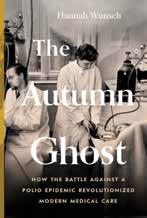
Hannah Wunsch ’93 Greystone Books, 2023
Two Danish doctors were desperate to help polio patients during the 1950s epidemic. Their methods created rudimentary treatment centers, which evolved into the intensive care
units we rely on today and informed care during the COVID-19 pandemic.
Ben and Beatriz: A Novel

Katalina Gamarra ’12 Graydon House, 2022
In this contemporary take on Much Ado About Nothing, a fiery standoff between two Harvard seniors begins with a horrible misunderstanding following a firstyear hookup. Three years later, the extremely privileged Ben and fiercely loyal Beatriz are thrown together again, but this time the stars just might align!
Florilla: A Pinelands Romance Perdita Buchan, former faculty Plexus Publishing, 2021

An abandoned child becomes the ward of a wealthy mill owner who raises her and prevents her malevolent father from exploiting her healing gifts. When she gets word of a well-intentioned arranged marriage, Florilla runs away to the forest, where she stumbles upon the English botanist who captures her heart.
Tulpa, Curtis Hughes ’88, New Focus Recordings, 2021
Collaborative energy unites the rhythmic, expressive music in Hughes’ Tulpa. This retrospective album assembles pieces from across 22 years, its continuity informed by Hughes’ musical relationships with some of Boston’s outstanding performers. Hughes was CA’s centennial composer-in-residence (page 8).

NOW: One of the great pianists and Hammond B3 organists of our time, Goldings returned to the Performing Arts Center in April, where he played the same Steinway piano and taught a master class for ensemble students. At CA, he mesmerized his audiences with his easy wit, self-deprecating stories, and brilliant musicianship.

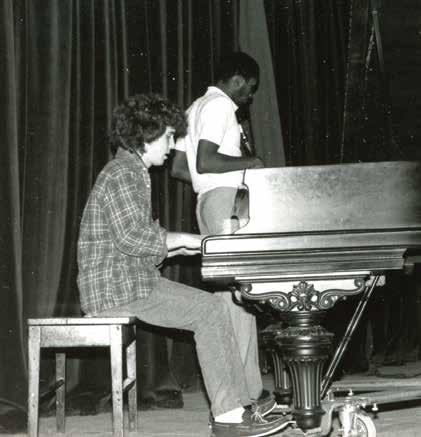
LEARN MORE
Read more about Goldings’ visit at concordacademy.org/goldings
“ This stage is very meaningful to me. I had some real important firsts here, while I figured out what the heck I was doing.”
LARRY GOLDINGS ’86
09.
after her.
10. Box of sketches: I
sketch of myself. Inside the box, there’s a huge stack of quick student self-portraits (I love index cards). They each have a recognizable, authentic style, even if they don’t think they do. So often in teaching, it’s our job to help kids see what they can do.
11. Books: I like to display some as conversation starters for advisees.




